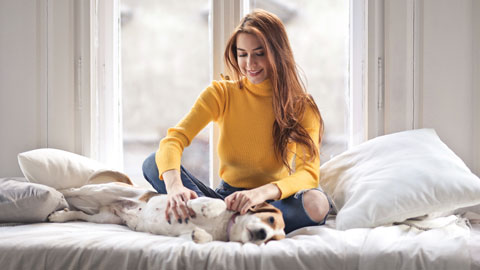In-Home Euthanasia
House Call Appointments
Your Pet Deserves For Their Last Moments To Be As Peaceful As Possible
I will be happy to consult with you over the phone about your pet’s unique situation. I will guide you by providing information on the process of death, aftercare, and memorializing your pet. As you make these decisions, you will receive my expertise, understanding, and support. I also can provide an in-home consultation on the day of your appointment.

Comfort & Sedation
After your pet is fully sedated and you are ready, a solution will be given that stops the heart within a few minutes. I will then listen to the heart to let you know when your best friend has passed away. Afterward, you may continue to spend time with your pet without distractions. A sedative will be given to help minimize restraint and give your pet relief from pain and mental anxiety. This allows your pet to fall into a deep and gentle sleep in your presence.
What Preparations Are Needed?
On the day of your appointment, you may feed your pet any amount or type of food, if the pet is still eating. Treats are fine as long as it does not upset your pet’s stomach: Make your pet happy. Continue giving any medications that are making your pet comfortable. These medications will not interfere with the sedation. While Dr. Westbrook does bring puppy pads, you may also provide a towel and a waterproof barrier to help prevent soiling if your pet happens to urinate during the appointment.


Cremation Options
We provide two types of Cremation, Private and Communal.
Communal Cremation
Your pet is cremated with multiple pets and their ashes are scattered in a memorial garden.
Private Cremation
Your pet is cremated by themselves and placed in a cedar box. We work with Pet Memories in Rockwall.
Deliever options:
1. (Free) Pick up from the crematory in Rockwall
2. (Free) They will deliver to your Veterinary Clinic if they are located: in Dallas County if they are east of the Dallas North Tollway, They deliver as far north as McKinney and Plano and to south Dallas. If you are unsure if your vet is in their delivery area, call me: 972-201-5342
3. ($55 shipping fee ) They will mail your ashes to your prefered address. They will contact you the day of shipping and give you the tracking #.
Commonly Asked Questions
How does the sedation work?
Sedation is given first to allow your pet to drift off to sleep. It is an injection that is given under the skin, just like a vaccine. The sedation does not take effect instantly: Most dogs start to become noticeably sedated between 3-5 minutes and cats after 2 minutes. Most pets will become totally sedated between 5 and 15 minutes, with 10 minutes being average. Dr. Westbrook does not believe in the one size fits all mentality. The sedative has multiple medications in it that are tailored to each pet’s symptoms and illness providing many mental and physical benefits.
- It contains a Valium-like product that helps prevent seizures and helps your pet mentally relax.
- Multiple products that help with pain and muscle relaxation.
- Anti-nausea and anti-vomiting preventive.
- An extra and stronger anti-seizure medication will be added for those with a history of seizure activity or with an illness that would make them prone to seizures.
Many pets will show obvious dream sequencing with sedation. Commons signs of dreaming include snoring, light twitches, REM eye movement, leg movement, and smiling/grinning. Some of the cats have also shown nursing/suckle behavior.
How will Dr. Westbrook know when your pet is asleep?
Each pet reacts to sedation differently. Not all pets close their eyes. This makes sense if you think about it: We all have heard of people that can sleep with their eyes open, and pets can do that too. Some pets naturally sleep with their eyes open, while others develop this habit when they become sick. When given, the sedative may take effect before your pet thinks to close its eyes. Your pet may be in a sleep state but have their eyes open or partially open. This is why Dr. Westbrook uses other ways to know that your pet is truly asleep. There is a natural reflex that every pet has, known as a “pull back” reflex. When your pet’s foot is massaged they will naturally pull it back, even under light sedation. As your pet fully experiences sedation they will lose this natural reflex. When your pet loses this reflex Dr. Westbrook will then place a puppy pad under them. If your pet reacts with this movement, Dr. Westbrook will know your pet needs more time or extra medication. Before the final injection is given most pets will need a small amount of hair clipped over the vein. Most pets will react to this if not under complete sedation. This is the final signal Dr. Westbrook watches for when she is monitoring the depth of sedation. Occasionally she will have “foolers” that give false indications of sedation. These are pets that just don’t follow the rules. Nothing bad happens, however, if she notices (as she is shifting them to get a better view of a vein) that they seem to not be fully asleep, she will stop and give them a little extra sedation.
What is the best way to give the sedation injection?
About 80% of dogs and 50% of cats will not care that they are getting a shot. The others will often show a mild reaction to the injection. Many pets are just not expecting an injection at home. They tend to react like they are stung by a bee. They may yelp or hiss. A few will turn and look over their shoulder at the area where the shot was given and behind them looking for the “Bee”. Typically they will settle right down once they realize the “Bee” is gone. One way to help bypass this reaction is to give a treat when giving the sedation (if your pet is still eating.) A mouth full of happiness goes a long way to make your pet comfortable.
What if my pet has high anxiety or aggression with strangers, or is scared of shots?
If your pet is averse to injections or has extreme anxiety or aggression with strangers, Dr. Westbrook recommends giving oral sedation before the appointment to help them relax. This is not required, but may be helpful for some pets. With an oral sedative your pet will still be able to move and will be aware of their surroundings, but with a reduced stress level. The goal during every appointment is to provide the best experience and last memories for your pet. If you think your pet would benefit from being given an oral sedative, Dr. Westbrook will be happy to give you a recommendation and guidance before the appointment.
What is the final injection, and how does it work?
The final injection is an anesthesia overdose. It is not one of the old products. It will not paralyze them or just stop the heart. This product works by going to the brain. The brain will then tell the body to shut down in stages. There is no “mental” awareness or pain when this happens. What you will notice is the breath will stop first and the heart will stop second. This injection is given in a vein and is very fast. Most pets pass within 1-3 minutes.
Do I have to stay during the appointment?
During the sedation period, your pet needs to have someone who they are comfortable with present. Many of Dr. Westbrook’s clients chose not to be in the room for the final injection. That is a very personal decision. Your pet will be in a comfortable mental state, dreaming and unaware at this point. They will not know if you opt to leave the room.
Burial & Cremation Options
Loving Paws Veterinary House Calls offers two cremation options for your beloved pets, communal cremation, and private cremation. We will take your pet with us at the time of the appointment and set everything up for you. If you choose, you may make your own arrangements.
Communal Cremation
Your pet will be communally cremated with other pets and then buried in a pet cemetery. You will not receive ashes back.
Private Cremation
Your pet will be individually cremated and hand-delivered to you by the crematory.
If you opt for a home body burial, you need to check with local ordinances. General guidelines recommend that you bury your pet 3 feet deep. If you are concerned with grave disturbance, it is recommended to cremate first and then bury.
Pet Caskets
You can buy professional pet caskets or you can make one. A lot of my small dogs and cat clients like to bury their pets in hat boxes. Another option, depending on your pet’s size, is a plastic tote.
Our Goal Is To Work With You And Your Pet To Improve All Aspects Of Your Pet’s Life
Unlike in human medicine, when we can no longer improve your pet’s quality of life you have the option to choose to help your pet die with dignity instead of letting your pet’s illness become a crisis.
The decision for end-of-life care needs to be made when medications or surgery can no longer improve your pet’s symptoms or quality of life.



